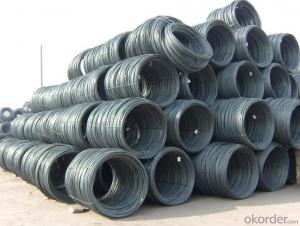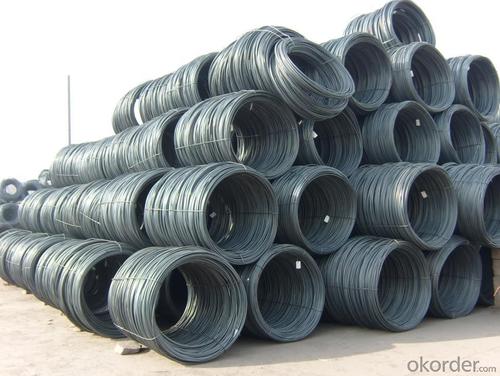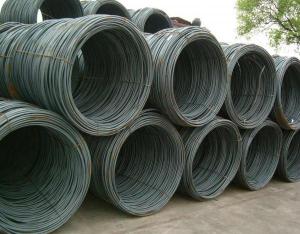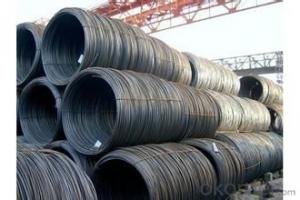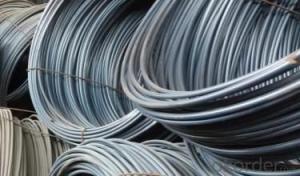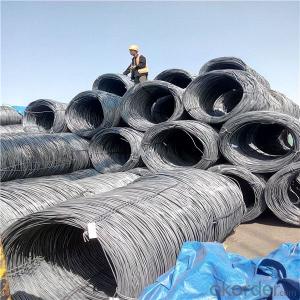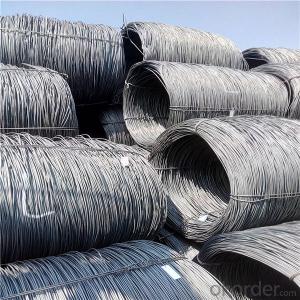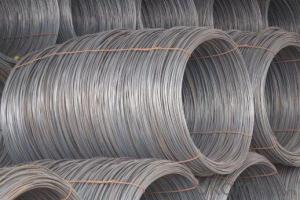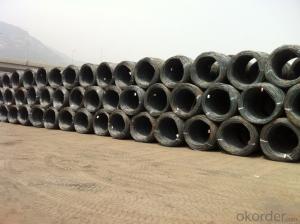Low Carbon Steel Wire Rod in Coil
- Loading Port:
- China Main Port
- Payment Terms:
- TT or LC
- Min Order Qty:
- 100 m.t.
- Supply Capability:
- 10000 m.t./month
OKorder Service Pledge
OKorder Financial Service
You Might Also Like
Product Description:
OKorder is offering Low Carbon Steel Wire Rod in Coil at great prices with worldwide shipping. Our supplier is a world-class manufacturer of steel, with our products utilized the world over. OKorder annually supplies products to African, South American and Asian markets. We provide quotations within 24 hours of receiving an inquiry and guarantee competitive prices.
Product Applications:
Low Carbon Steel Wire Rod in Coil are ideal for structural applications and are widely used in the construction of buildings and bridges, and the manufacturing, petrochemical, and transportation industries.
Product Advantages:
OKorder's Low Carbon Steel Wire Rod in Coil are durable, strong, and wide variety of sizes.
Main Product Features:
· Premium quality
· Prompt delivery & seaworthy packing (30 days after receiving deposit)
· Mill test certification
· Professional Service
· Competitive pricing
Product Specifications:
Steel Grade: Q195/235, SAE1006-1018B
Standard: ASTM, GB
Diameter: 5.5mm, 6.5mm, 7mm,8mm,9mm,10mm,12mm,14mm
Type: in coil, coil weight around 2MT
Alloy or Not: Alloy
Technique: Hot Rolled
Place of Origin: China Mainland
Surface: round, no twisted, light and smooth
FAQ:
Q1: Why buy Materials & Equipment from OKorder.com?
A1: All products offered byOKorder.com are carefully selected from China's most reliable manufacturing enterprises. Through its ISO certifications, OKorder.com adheres to the highest standards and a commitment to supply chain safety and customer satisfaction.
Q2: How many tons of steel products could be loaded in containers?
A2: Usually the steel products are delivered by bulk vessel because of the large quantity and the freight. However, there are no bulk vessel enter some seaports so that we have to deliver the cargo by containers. The 6m steel product can be loaded in 20FT container, but the quantity is changed according to the size, usually from 18tons to 25tons
Q3: How soon can we receive the product after purchase?
A3: Within three days of placing an order, we will arrange production. The normal sizes with the normal grade can be produced within one month. The specific shipping date is dependent upon international and government factors, the delivery to international main port about 45-60days.
Images:
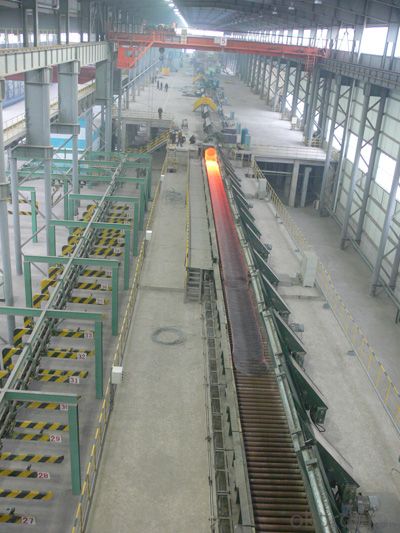
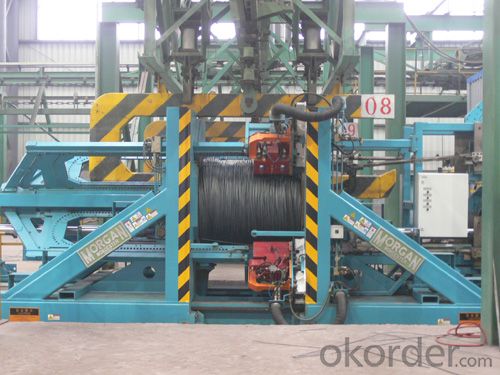
- Q: What are the common defects that can occur during the processing of steel wire rod?
- Some common defects that can occur during the processing of steel wire rod are surface cracks, internal voids or inclusions, uneven dimensions, and incorrect chemical composition.
- Q: How is steel wire rod inspected for quality control?
- Steel wire rod is inspected for quality control through various methods. One common approach is visual inspection, where trained personnel examine the rod for any surface defects, such as cracks, pits, or irregularities in shape. Additionally, dimensional measurements are taken to ensure the rod meets the required specifications. Mechanical testing is also conducted, including tensile strength and hardness tests, to assess the rod's strength and durability. Furthermore, non-destructive testing techniques such as ultrasonic or magnetic particle inspection may be used to detect internal flaws or defects. These comprehensive inspection procedures help ensure that steel wire rod meets the highest quality standards before it is used in various industries.
- Q: What are the common industry standards for steel wire rod distributors?
- The common industry standards for steel wire rod distributors typically include compliance with international quality standards such as ASTM, ISO, and EN. These standards cover various aspects including chemical composition, mechanical properties, dimensions, and surface quality of the wire rods. Additionally, distributors often adhere to specific industry certifications and regulations to ensure the products meet customer requirements and are safe for use in various applications.
- Q: What are the different types of wire brushes made from steel wire rod?
- There exist various wire brushes produced from steel wire rods, each with its own purpose and application. 1. The hand wire brush, the most commonly used type, is suitable for general cleaning and surface preparation. It comprises steel wire bristles attached to a handle, allowing for easy manual use. 2. Cup wire brushes possess a cup-shaped body with steel wire bristles around the edge. They are often employed for removing paint, rust, and corrosion from large surfaces or irregular shapes. 3. Wheel wire brushes, circular in shape, feature steel wire bristles around the outer edge. They are commonly utilized in power tools like angle grinders or bench grinders, making them ideal for heavy-duty tasks such as weld cleaning or deburring. 4. Twisted wire brushes are created by twisting multiple strands of steel wire together. This design provides a more aggressive brushing action, making them suitable for tasks that require abrasive cleaning or surface preparation. 5. Knot wire brushes resemble twisted wire brushes, but each wire strand has individual knots at the end. These brushes are particularly effective in removing heavy rust, scale, or weld spatter from metal surfaces. 6. Strip brushes consist of steel wire bristles attached to a flexible metal or plastic strip. They are commonly employed for sealing or cleaning purposes, such as door seals, conveyor belt cleaning, or surface dusting. 7. Scratch brushes are small handheld wire brushes, often used for cleaning small and hard-to-reach areas. They find common applications in jewelry making, electronics, or precision cleaning tasks. Each of these wire brushes made from steel wire rods possesses distinct features and characteristics suitable for various cleaning, surface preparation, or finishing tasks. The selection of the appropriate wire brush for a specific application is crucial in achieving efficient and effective results.
- Q: What are the main factors affecting the product competitiveness of steel wire rod?
- The main factors affecting the product competitiveness of steel wire rod include the quality and consistency of the product, pricing competitiveness, delivery reliability, customer service, technical support, and the ability to meet specific customer requirements. Additionally, factors such as the reputation and brand image of the manufacturer, market demand and trends, competition from other suppliers, and the cost and availability of raw materials also play a significant role in determining the product's competitiveness.
- Q: How is steel wire rod used in the manufacturing of wire forms for jewelry findings?
- Steel wire rod is an essential component in the manufacturing of wire forms for jewelry findings. It serves as the primary raw material that is transformed into various shapes and sizes to create different types of wire forms. The first step in utilizing steel wire rod for jewelry findings is to determine the required diameter and length of the wire. This is crucial as it determines the strength and flexibility of the final product. Once the specifications are established, the steel wire rod is cut into smaller sections, which are then straightened and polished. After the initial preparation, the wire rod is shaped and manipulated using specialized tools and techniques. For example, it can be bent, twisted, or coiled to create different wire forms such as jump rings, ear wires, clasps, and connectors. These wire forms are integral parts of jewelry findings, which are the small components that hold jewelry pieces together. The use of steel wire rod in manufacturing wire forms for jewelry findings offers several advantages. Firstly, steel is a durable and robust material, providing strength and stability to the final product. This ensures that the wire forms can withstand the rigors of everyday wear and tear. Additionally, steel wire rod is resistant to corrosion, making it suitable for long-lasting jewelry pieces. Moreover, steel wire rod allows for a wide range of design possibilities. It is highly malleable and can be easily shaped into intricate patterns and designs, adding aesthetic appeal to the jewelry findings. The versatility of steel wire rod enables jewelry designers to create unique and customized wire forms that suit individual preferences. In conclusion, steel wire rod is an essential component in the manufacturing of wire forms for jewelry findings. Its strength, durability, resistance to corrosion, and malleability make it an ideal material for creating various wire forms such as jump rings, ear wires, clasps, and connectors. By utilizing steel wire rod, jewelry manufacturers can produce high-quality and aesthetically pleasing jewelry findings that enhance the overall design and functionality of jewelry pieces.
- Q: What are the main factors influencing the choice of steel wire rod quality standards?
- The main factors influencing the choice of steel wire rod quality standards are: 1. Application requirements: The intended use of the steel wire rod plays a significant role in determining the quality standards. Different industries have specific requirements for strength, durability, corrosion resistance, and other mechanical properties. The choice of quality standards depends on meeting these application-specific needs. 2. National and international regulations: Steel wire rod quality standards are often regulated by national and international bodies such as ASTM (American Society for Testing and Materials), ISO (International Organization for Standardization), and EN (European Norms). Compliance with these standards is essential to ensure that the steel wire rod meets the necessary safety and performance requirements. 3. Customer specifications: Customers may have their own specific quality standards or requirements that need to be met. These specifications can include chemical composition, mechanical properties, surface finish, and dimensional tolerances. Meeting these customer specifications is crucial to ensuring customer satisfaction and maintaining long-term business relationships. 4. Quality assurance and control: Manufacturers and suppliers of steel wire rod often have their own internal quality assurance and control processes. These processes may include inspections, testing, and certifications to ensure that the wire rod meets the required quality standards. The choice of quality standards is influenced by the manufacturer's ability to meet these internal quality control measures. 5. Cost considerations: The choice of steel wire rod quality standards can also be influenced by cost considerations. Higher quality standards may require more stringent manufacturing processes, testing, and inspections, which can result in higher production costs. Manufacturers and customers need to strike a balance between quality and cost to ensure competitiveness in the market. Overall, the main factors influencing the choice of steel wire rod quality standards are application requirements, national and international regulations, customer specifications, quality assurance and control processes, and cost considerations. By considering these factors, manufacturers and customers can select the appropriate quality standards to meet their specific needs and ensure the desired performance and reliability of the steel wire rod.
- Q: What are the main factors affecting the formability of steel wire rod?
- The main factors affecting the formability of steel wire rod include the composition and quality of the steel, the temperature at which the forming process takes place, the speed and force applied during forming, and the presence of any impurities or defects in the material. Additionally, the diameter and shape of the wire rod, as well as the lubrication used during forming, can also influence its formability.
- Q: What are the main factors influencing the choice of steel wire rod production process?
- The main factors influencing the choice of steel wire rod production process include the desired quality and characteristics of the final product, the availability and cost of raw materials, the required production capacity, the level of automation and technology available, the environmental impact of the process, and the market demand for different types of steel wire rod.
- Q: What are the different formability testing methods for steel wire rod?
- There are several different formability testing methods that can be used to evaluate the behavior of steel wire rod. These methods are designed to assess the ability of the wire rod to deform and bend without cracking or breaking. Some of the common formability testing methods for steel wire rod include: 1. Cupping test: This test involves placing a blank of the steel wire rod into a shallow die and applying a controlled force to deform the material. The depth of the cup formed before cracking or fracturing occurs is measured to evaluate the formability of the wire rod. 2. Erichsen test: In this test, a hemispherical punch is used to deform the steel wire rod until a crack or fracture occurs. The maximum punch depth before failure is measured and used as an indicator of the wire rod's formability. 3. Tensile test: This is a widely used test to evaluate the mechanical properties of materials, including the formability of steel wire rod. The wire rod is pulled in tension until it fractures, and various parameters such as elongation, reduction in area, and ultimate tensile strength are measured and analyzed. 4. Bend test: This test involves bending the wire rod to a specified angle and examining the surface for cracks or fractures. The angle at which the wire rod fails to maintain its original shape indicates its formability. 5. Flattening test: In this test, the wire rod is flattened between two parallel plates until it fractures. The maximum load or pressure required to cause failure is measured and used as an indicator of formability. 6. Hole expansion test: This test evaluates the ability of the wire rod to deform and expand without cracking when subjected to a punching force. The maximum hole diameter that can be obtained without failure is measured, indicating the formability of the wire rod. These formability testing methods help manufacturers and researchers assess the suitability of steel wire rod for various applications, such as automotive components, construction materials, and manufacturing processes. By understanding the formability characteristics of the wire rod, engineers can make informed decisions regarding material selection and process optimization.
Send your message to us
Low Carbon Steel Wire Rod in Coil
- Loading Port:
- China Main Port
- Payment Terms:
- TT or LC
- Min Order Qty:
- 100 m.t.
- Supply Capability:
- 10000 m.t./month
OKorder Service Pledge
OKorder Financial Service
Similar products
Hot products
Hot Searches
Related keywords
